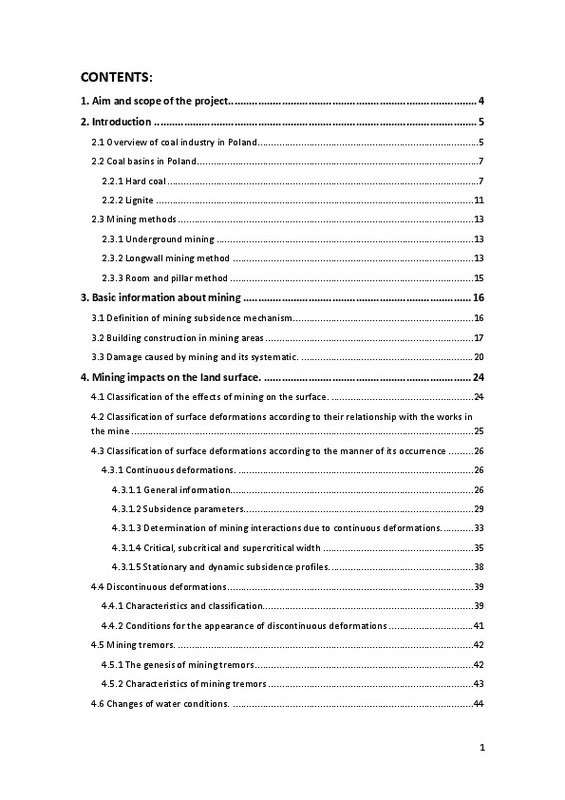JavaScript is disabled for your browser. Some features of this site may not work without it.
Buscar en RiuNet
Listar
Mi cuenta
Estadísticas
Ayuda RiuNet
Admin. UPV
Protection of buildings in mining areas
Mostrar el registro sencillo del ítem
Ficheros en el ítem
| dc.contributor.advisor | Dawczynski, Szymon
|
es_ES |
| dc.contributor.advisor | Fernández Plazaola, Igor
|
es_ES |
| dc.contributor.author | Royuela Mesa, Borja
|
es_ES |
| dc.date.accessioned | 2015-11-24T11:34:56Z | |
| dc.date.available | 2015-11-24T11:34:56Z | |
| dc.date.created | 2015-09-26 | |
| dc.date.issued | 2015-11-24 | |
| dc.identifier.uri | http://hdl.handle.net/10251/57990 | |
| dc.description.abstract | Trabajo Fin de Grado en modalidad Intercambios Académicos : Politechnika Śląska, Gliwice (Polska-Poland) | es_ES |
| dc.description.abstract | [EN] The scope of the project is giving the theoretical explanation of the impact that mining exploitation cause in the ground, both surface and subsoil, as well as its effect on thestructure of nearby buildings. Mining exploitation produces unfavorable effects in the environment. The project will focus on the coal mining industry as Poland is one of the biggest coal producers in the world. Subsidence is an inevitable consequence of underground mining. It may be small and localized or extend over large areas; it may be immediate or delayed for many years. Deformation that occur on the ground due to mining exploitation produce new forces that affect to the structure of buildings located in the area of effect of the mining exploitation. Due to the damage that subsidence can cause to the structures, communications and agricultural lands is important to know how to predict ground movements, determine the effects of such movements on structures and minimize the damage due to subsidence. The project is divided in three parts. The first part explains how deformations occur and its impact on the land surface. As deformation of the ground due to mining exploitation is unavoidable, the second part describes damages on buildings and construction techniques employed to reduce the damage to buildings. The project focuses on residential buildings, as rigid structures, both new and existing buildings. The last part of the project consists in a practical case and explains how to calculate the forces acting on the building foundation due to impact of area horizontal deformation and protection design of the foundation framework | es_ES |
| dc.format.extent | 111 | es_ES |
| dc.language | Inglés | es_ES |
| dc.publisher | Universitat Politècnica de València | es_ES |
| dc.rights | Reserva de todos los derechos | es_ES |
| dc.subject | Mines and mineral resources | es_ES |
| dc.subject | Coal mines and mining | es_ES |
| dc.subject | Buildings | es_ES |
| dc.subject | Foundations | es_ES |
| dc.subject | Structural engineering | es_ES |
| dc.subject | Risk assessment | es_ES |
| dc.subject | Minas | es_ES |
| dc.subject | Edificios | es_ES |
| dc.subject | Cimentaciones | es_ES |
| dc.subject | Estructuras (Construcción) | es_ES |
| dc.subject | Evaluación del riesgo | es_ES |
| dc.subject.classification | ORGANIZACION DE EMPRESAS | es_ES |
| dc.subject.other | Grado en Arquitectura Técnica-Grau en Arquitectura Tècnica | es_ES |
| dc.title | Protection of buildings in mining areas | es_ES |
| dc.type | Proyecto/Trabajo fin de carrera/grado | es_ES |
| dc.rights.accessRights | Abierto | es_ES |
| dc.contributor.affiliation | Universitat Politècnica de València. Escuela Técnica Superior de Gestión en la Edificación - Escola Tècnica Superior de Gestió en l'Edificació | es_ES |
| dc.description.bibliographicCitation | Royuela Mesa, B. (2015). Protection of buildings in mining areas. http://hdl.handle.net/10251/57990. | es_ES |
| dc.description.accrualMethod | Archivo delegado | es_ES |
Este ítem aparece en la(s) siguiente(s) colección(ones)
-
ETSIE - Trabajos académicos [2383]
Escuela Técnica Superior de Ingenieria de Edificación





![ZIP archive [ZIP]](/themes/UPV/images/zip.png)

